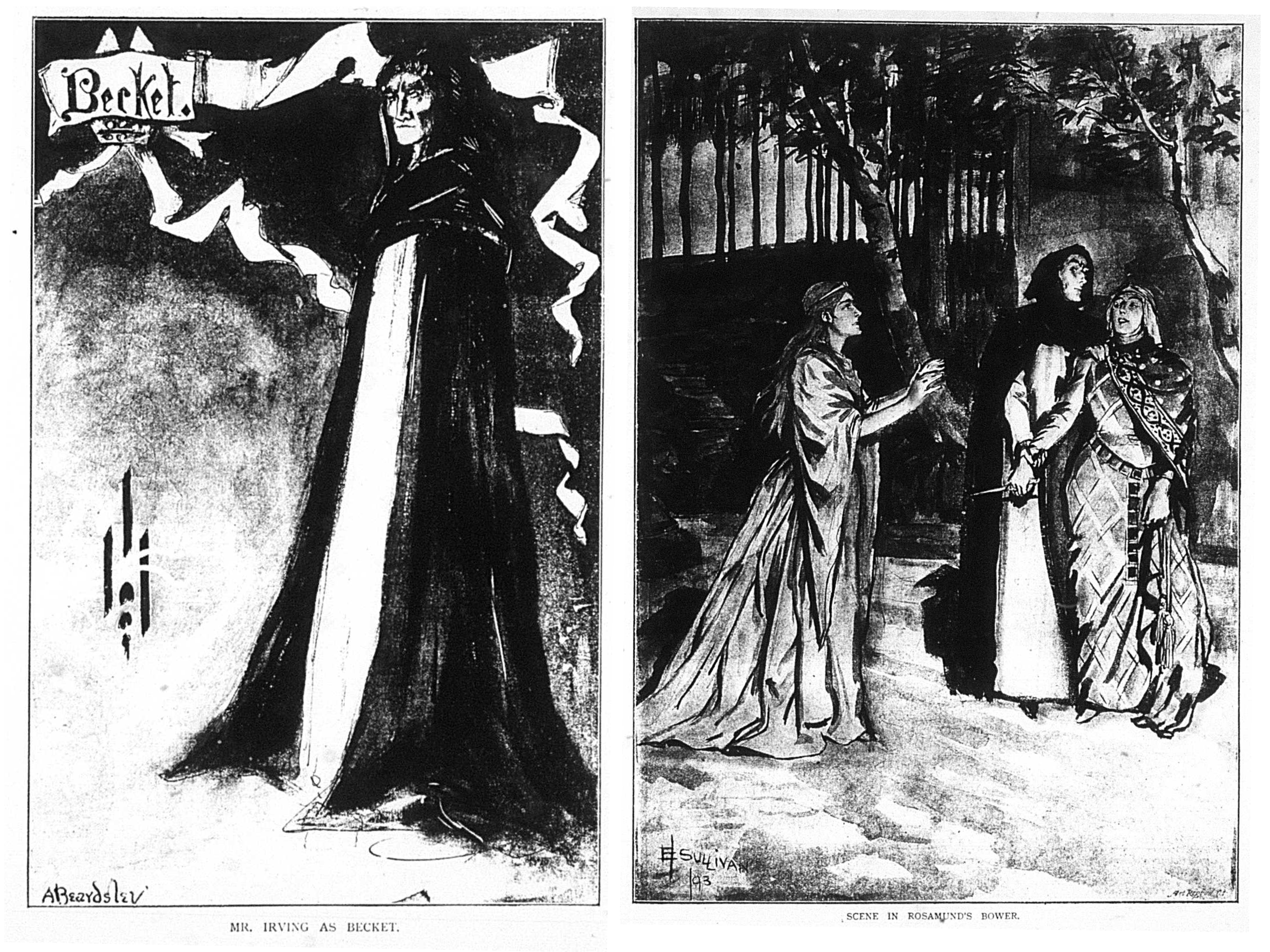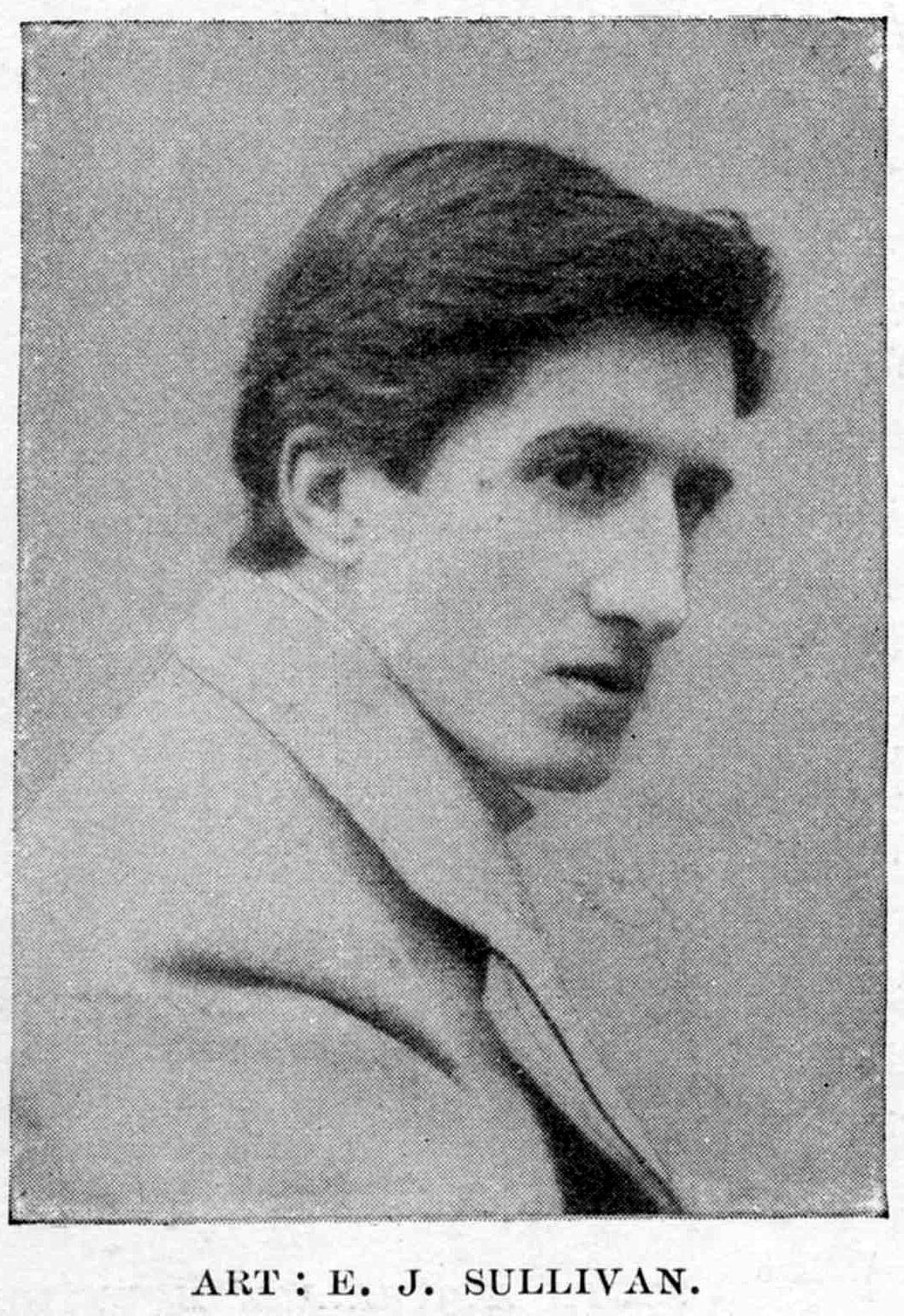Edmund Joseph Sullivan was a British illustrator, painter, and print-maker born in Putney, South-West London on 8 September 1869. He was to have nine siblings, six brothers and three sisters. His father Michael Sullivan (1840-1914) was an art teacher who in 1875 was appointed head of the newly opened Hastings School of Art, a post that he was to hold for 40 years. Sullivan was educated at Mount St. Mary’s College near Chesterfield, a Roman Catholic boarding school run by Jesuits. His only formal art training was at home and from 1885 he studied under his father.
His first job was at the Daily Graphic (1890-1926), where he drew the majority of the portraits that appeared in its pages. After two years the editor found his work too distinctly artistic and he was dismissed. He worked freelance for a time, mainly for magazines, before joining the staff of The Pall Mall Budget (1868-1920). On taking over as editor in 1893, G. R. Halkett (1900-1983) gathered a new team of capable artists, including Sullivan, Aubrey Beardsley (1872-1898), A. S. Hartrick (1864-1950), and Joseph Pennell (1857-1926). Sullivan’s contributions were mostly full-page pen-and-wash drawings illustrating various theatrical reviews. These included one full-page picture of Henry Irving and Ellen Terry in a performance of Alfred Tennyson’s Becket at the Lyceum in February 1893. The same review also had one full-page illustration and five small sketches by Aubrey Beardsley (fig. 1).

It was at the Pall Mall Budget that Sullivan met Frances Louise Williams (1868–1949), whom he married on 18 July 1894 and who was to be a great support to him in his work. A. S. Hartrick was best man at their wedding. Their only child, Lilian Eileen, was born on 4 September 1895.
In July 1894 Sullivan contributed two drawings to the second volume of The Yellow Book, “The Old Man’s Garden” and “The Quick and the Dead.” It was not until 1897 that he contributed again, supplying four contrasting pen-and-ink drawings of beautiful women: “Helen,” “The Sorceress,” “The Couch,” and “The Mirror.” In the meantime, for Macmillan he had made a fine set of illustrations to a new edition of Lavengro by George Borrow (1803-1881), published in 1896.
In 1895 Joseph Pennell, whom Sullivan had met at the Pall Mall Budget , helped him on his way as a commercial artist, getting him a commission to contribute an illustration to a series of articles on life in London in The Daily Chronicle. Pennell also recruited him to the Society of Illustrators, whose members illustrated A London Garland, an anthology of verse. Members included Aubrey Beardsley, Robert Anning Bell (1863-1933), Hartrick, J. M. Whistler (1834-1903), and Jack B. Yeats (1871-1957).
In 1898 Sullivan illustrated a new edition of Sartor Resartus (1836) by Thomas Carlyle (1795-1881) for George Bell & Sons. He made a number of highly original and in some cases experimental drawings in a variety of styles that attempted, often successfully, to capture the broad concepts and abstruse arguments of the text. The book received glowing reviews and the drawings were exhibited several times in the years that followed, but the public did not agree with the critics and sales were slow.
Some of Sullivan’s best work was published in the pages of the Pall Mall Magazine (1893-1914), and in 1899 he started on a high note with a series of illustrations for five short stories by H. G. Wells (1866-1946). These were collectively labelled as “Stories of the days to come” and set in the year 2090. The drawings are powerful, easily capturing the size and strength of the structures that Wells describes, and emphasizing the frailty and vanity of their inhabitants.
In July 1899 Sullivan was engaged by the publisher Grant Richards to illustrate A Dream of Fair Women, a selection of Tennyson’s poems. Although not all the illustrations successfully complement the text, the book contains many dramatic and beautiful drawings. The same year, he contributed 19 drawings to The Natural History of Selborne by Gilbert White (1729-1793), which was brought out in a sumptuous two-volume edition by Freemantle.
In 1901 Sullivan was asked to illustrate John Bunyan’s The Pilgrim’s Progress , to be published in George Newnes’s “Caxton” series. For this he made 20 full-page illustrations in line. The subject inspired him and the best of the drawings are immensely imaginative and powerful.
The next important commission came in 1908. It was to illustrate a new edition of Sintram and his Companions by Friedrich de la Motte Fouqué (1777-1843) for Methuen. The story draws on Norse literature, culture, and mythology, merged with Christian themes. With its scenes of battle, storm, and magic, interspersed with periods of calm, it provided a fitting subject for Sullivan’s talents.
Also in 1908 Sullivan started to teach illustration and lithography at Goldsmiths College School of Art, offering both daytime and evening classes on a part-time basis. He became a highly respected member of the staff there for the next 20 years.
As early as 1899 he had proposed to George Bell that he should illustrate Carlyle’s French Revolution, but it was not until 1910 that Chapman and Hall published an edition of the book with his illustrations. It included 33 full-page illustrations which are amongst his finest work, full of symbolism and emotion.
Sullivan had long been interested in illustrating Edward Fitzgerald’s translation of The Rubáiyát of Omar Khayyám (1859). In 1900 he had made 16 illustrations to the poem, and four quatrains with his illustrations were published in the Pall Mall Magazine in 1901. However, it was not until the autumn of 1913 that an edition was published with 75 of his line drawings, one to each quatrain, very well reproduced by photogravure.
With the onset of the First World War there was a demand for cartoons, and Sullivan was commissioned by William Heinemann to make 44 drawings to be published in an album called The Kaiser’s Garland. The book is a powerful tirade against the folly of war and of Kaiser Wilhelm II in particular, and all of the symbols of evil, greed, and decadence that he used in titles such as Sartor Resartus and The Pilgrim’s Progress are deployed, along with many new ones.
Sullivan was essentially an illustrator in black and white and, after the war, the market for such artwork diminished. He illustrated an edition of Tennyson’s Maud (1855) in 1921 and two volumes in a series of Robert Louis Stevenson’s works in 1928 for Macmillan, but little else. He set out his theories of The Art of Illustration in 1921, and his methods of drawing in Line in 1922. He became more dependent on teaching and on his etchings, which were then in fashion. As early as 1912 the New York Public Library added two of his lithographs to its collection.
Sullivan was elected an Associate of the Royal Society of Painters in Watercolours in 1913 and a full member in 1929. He became a Guildsman at the Art Workers’ Guild in 1911 and its master in 1931. He was elected an Associate of the Royal Society of Painter-Etchers and Engravers in 1925 and a member in 1931. He died at home, at 18 Hill Road, St. John’s Wood, London on 17 April 1933.
©2018, Geoffrey Beare
Geoffrey Beare is a freelance writer and researcher in the history of book illustration. He is chairman of the Imaginative Book Illustration Society and a trustee of the William Heath Robinson Trust. He is the volunteer Collection and Exhibitions Manager at The Heath Robinson Museum in Pinner, North-West London.
Selected Publications by E. J. Sullivan
- The Art of Illustration. Chapman and Hall, 1921.
- Line: An Art Study. Chapman and Hall, 1922.
Selected Publications with Illustrations by E. J. Sullivan
- Borrow, George. Lavengro. Macmillan, 1896.
- Bunyan, John. The Pilgrim’s Progress. 2 vols, George Newnes, 1901.
- Carlyle, Thomas. The French Revolution: A History. 2 vols, Chapman and Hall, 1910
- —. Sartor Resartus. George Bell & Sons, 1898.
- de la Motte Fouqué, Friedrich. Sintram and his Companions . Methuen, 1908.
- FitzGerald, Edward, trans. The Rubaiyat of Omar Khayyam. Methuen , 1913.
- Goldsmith, Oliver. The Vicar of Wakefield. Constable, 1914.
- Sullivan, E. J. “I. Helen.” The Yellow Book, vol. 13, April 1897, p. 227. The Yellow Nineties Online. Edited by Dennis Denisoff and Lorraine Janzen Kooistra. http://1890s.ca/HTML.aspx?s=YBV13_sullivan_helen.html.
- —. “II. The Sorceress.” The Yellow Book, vol. 13, April 1897, p. 229. The Yellow Nineties Online. Edited by Dennis Denisoff and Lorraine Janzen Kooistra. http://1890s.ca/HTML.aspx?s=YBV13_sullivan_sorceress.html.
- —. “III. The Couch.” The Yellow Book, vol.13, April 1897, p. 231 The Yellow Nineties Online. Edited by Dennis Denisoff and Lorraine Janzen Kooistra. http://1890s.ca/HTML.aspx?s=YBV13_sullivan_couch.html.
- —. “IV. The Mirror.” The Yellow Book, vol. 13, April 1897, p. 233. The Yellow Nineties Online. Edited by Dennis Denisoff and Lorraine Janzen Kooistra. http://1890s.ca/HTML.aspx?s=YBV13_sullivan_couch.html.
- —. “Scene in Rosamund’s Bower from Becket at the Lyceum.” Pall Mall Budget, 9 Feb. 1893, p. 189.
- —. The Kaiser’s Garland. William Heinemann, 1915.
- —. “The Old Man’s Garden.” The Yellow Book, vol. 2, July 1894, p. 271. The Yellow Nineties Online. Edited by Dennis Denisoff and Lorraine Janzen Kooistra. Ryerson University, 2010. http://www.1890s.ca/HTML.aspx?s=YB2_sullivan_old_man.html.
- —. “The Quick and the Dead.” The Yellow Book, vol. 2, July 1894, p. 273. The Yellow Nineties Online. Edited by Dennis Denisoff and Lorraine Janzen Kooistra. http://www.1890s.ca/HTML.aspx?s=YB2_sullivan_quick_and_dead.html.
- Tennyson, Alfred Lord. A Dream of Fair Women. Grant Richards, 1900.
- —. Maud: A Monodrama. Macmillan, 1922.
Selected Publications about E. J. Sullivan
- Beare, Geoffrey. “The Master of Line: The Illustrations of Edmund Joseph Sullivan.” IBIS Journal, no. 6, 2018, pp. 7-68.
- Bradshaw, Percy V. The Art of the Illustrator: E. J. Sullivan and his Work . Press Art School, [1916].
- Houfe, Simon. “An Artist’s Artist: The Illustrations of E. J. Sullivan,” Country Life, vol. 2, May 1985, pp. 1194-96.
- Thorpe, James. E. J. Sullivan. Art and Technics,1948.
MLA citation:
Beare, Geoffrey. “Edmund Joseph Sullivan (1869-1933),” Y90s Biographies. Yellow Nineties 2.0,edited by Lorraine Janzen Kooistra, Ryerson University Centre for Digital Humanities, 2019, https://1890s.ca/sullivan_bio/.
